Anthony Geathers for Rolling Stone
The Power of
Black Lives
Matter
How the movement that’s changing America was built and where it goes next
Two days after a Minneapolis cop killed George Floyd in late May, the novel coronavirus tallied its 100,000th American victim. More than 22,000 of those lost were black, though we only make up 13 percent of the overall U.S. population. As the global pandemic was laying bare virtually all of America’s structural inequalities, unrest on the Minneapolis streets swelled into the largest and most numerous public demonstrations for civil rights seen in generations. Tens of thousands of nonviolent protesters from various cultural backgrounds, in city after city, are crying out “black lives matter,” the mantra of the modern civil-rights movement and the rallying cry against the casual acceptance of our deaths.
Civil-rights organizers Alicia Garza, Patrisse Cullors, and Opal Tometi put those three words into our minds and hearts seven years ago, when they began to change the country. The sweeping calls for change we see today are not sudden, but the fruits of the labor of activists like them. Their work has given us room to demand more, because black lives don’t truly matter just because people simply say so. This year alone, a white father and son carried out the modern-day lynching of 25-year-old Ahmaud Arbery near Brunswick, Georgia. If black lives mattered by now, we wouldn’t have to say the name of Breonna Taylor, lost to a hail of police bullets in her own home in Louisville in March. Or chant the name of Floyd, killed for allegedly spending a counterfeit twenty-dollar bill at a corner grocery.
The protesters mobilized quickly and with unapologetic fury, their range of targets plentiful, whether it be overly militarized policing or inadequate medical services; mass incarceration or bigotry in the workplace; food insecurity or housing, Confederate monuments or racism in the entertainment industry. As “black lives matter” rings out from the mouths of protesters and corporations alike, what will it take to build an America where those three words are a statement of fact — not a fight for survival?
It was seven years ago this July that Garza reacted to George Zimmerman’s acquittal of murder in the Trayvon Martin case with a viral Facebook post expressing her pain, writing: “Black people. I love you. I love us. Our lives matter. Black Lives Matter.”“I was impacted in a way that I didn’t expect,” Garza tells me. “We see black death all the time, and I don’t know what it was about this, but I know I went home and then I woke up in the middle of the night crying. And I picked up my phone and I started clickety-clacking, right?” Garza is now the principal of the Black Futures Lab, which works with voters and produces a Black Census Report. Patrisse Cullors, a Southern California activist close to Garza, saw the post and added the hashtag #blacklivesmatter. In New York City, immigration organizer Opal Tometi learned of the Zimmerman verdict after leaving a screening of the Ryan Coogler film Fruitvale Station, about the 2009 police shooting that killed Oscar Grant III. Already emotional, Tometi then read Garza’s viral post.
“That is what hit me,” Tometi says. “There [was] a lot of rage, a lot of pain, a lot of cynicism. But her post resonated with me, for a number of reasons. I think it being explicitly black, it being a message rooted in love, and it just felt very hopeful.”
By the next day, Tometi, who knew Garza through the Black Organizing for Leadership and Dignity Network, contacted her fellow organizer. She hadn’t yet met Cullors, but in short order, the three joined forces and launched the Black Lives Matter Global Network.
“Patrisse and I, we started talking about building an organizing project around state violence,” Garza said about the Global Network’s founding. “Patrisse had been working on her own stuff at the time — the Dignity and Power Now. She was just getting that off the ground. All of this stuff kind of came into synergy. I knew designers and artists here in the Bay [Area] who were really excited to help and reached out and said, ‘What can we do?’ And so that’s really the genesis of this.”
Garza says Black Lives Matter was not initially her full-time job. But after the shooting death of Michael Brown Jr. by officer Darren Wilson in 2014, a Freedom Ride to Ferguson, Missouri, came together. Cullors, writing with co-organizer Darnell L. Moore in The Guardian that September, described the bus ride with 40 others in the spirit of the Freedom Rides across the segregated South during the early 1960s as “a tangible example of self-determination in the face of anti-black violence on the part of Ferguson residents and those of us who traveled from across the country to join them.”
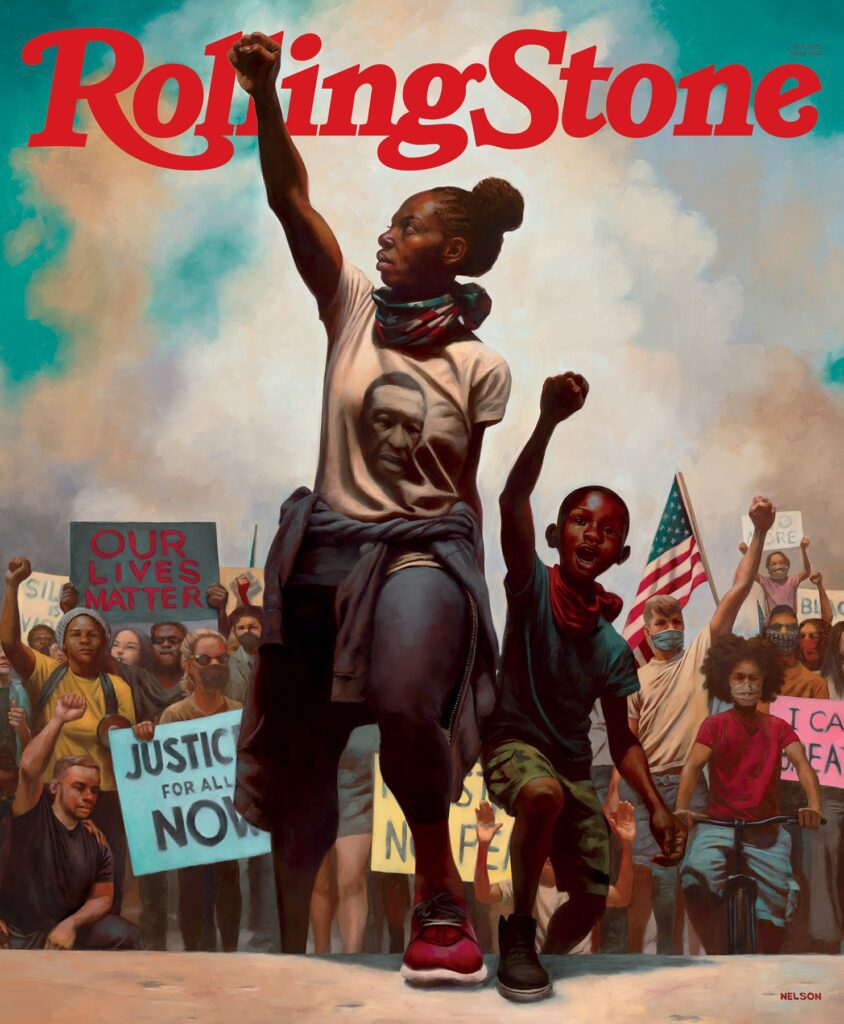
“American Uprising”
Illustration by Kadir Nelson for Rolling Stone
“I probably was the one out of the three of us that was like, ‘Let’s go, let’s get big, let’s get everybody.’ I wasn’t necessarily thinking about organizational structure,” Cullors says today. “I was mostly thinking about building a mass movement that people can be a part of and feel an identity around. I was interested in giving folks like black, poor people who’ve been marginalized, brutalized, an opportunity to have more visibility. Before seven years ago, we could barely get the news to talk about police violence, let alone police death.”
Garza also remembers how merely asking that black lives matter was too much for America, even in the wake of Zimmerman’s acquittal. “On a political landscape, Black Lives Matter was just dead in the water,” she says. “When you look at those polls, basically saying anything about Black Lives Matter — [it] just made everybody mad. And so from a political standpoint, you couldn’t bring Black Lives Matter into a state legislature, because Black Lives Matter was synonymous in people’s heads to, like, the Black Panther Party, and people were not fucking with it.”
They’re fucking with it now. In the wake of Floyd’s death, corporations that wouldn’t have gone near racial controversy in 2013 are now saying black lives matter. Even NFL commissioner Roger Goodell, whose league exiled quarterback Colin Kaepernick after he knelt in nonviolent protest against police violence and systemic racism during the 2016 season, has had a change of heart. It’s part of a broad Caucasian confession session: The Boston Red Sox are apologizing for fans hurling racial slurs at black players, NASCAR is banning the Confederate flags that typically flood their stands, and Paramount is canceling the squalid Cops, squashing television’s cockroach after more than three decades of glorifying police brutality and dehumanizing victims of it.
“One of the things about Black Lives Matter is that it’s become a rallying cry. That’s really important,” documentarian Stanley Nelson Jr., who has chronicled everyone from Marcus Garvey to the Black Panthers, tells me as he speaks about the value of slogans in movements. “How many white people do you see out there with signs that say, ‘Black Lives Matter,’ just like kneeling and holding up a fist has become a symbol?”
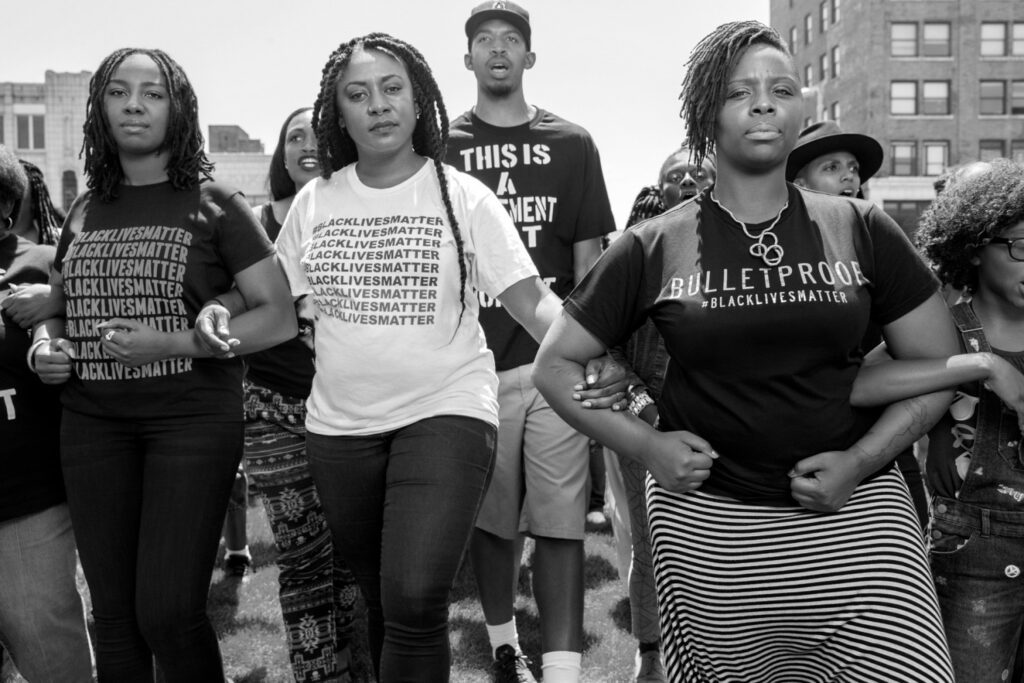
FIGHTING THE POWER: Opal Tometi, Alicia Garza, and Patrisse Cullors (from left), founders of Black Lives Matter, in Cleveland, after the 2014 killing of Tamir Rice.
Ben Baker/Redux
The public is also, belatedly, recognizing the reality of police racism and brutality, particularly as smartphones capture it on film in clips that go viral on social media. Nineteen percent of Gallup respondents on June 10th said that “race relations or racism” is the most important problem in the U.S., up from just four percent the month before and the highest such total the poll has measured since another pivotal year: 1968. A June 2nd Monmouth survey indicated that “a majority of Americans (57 percent) say that police officers facing a difficult or dangerous situation are more likely to use excessive force” against black individuals, “compared to one-third (33 percent) who say the police are just as likely to use excessive force against black and white culprits in the same type of situation.” Compare that with the same poll in the summer of 2016, when two Baton Rouge, Louisiana, cops shot Alton Sterling dead, and only 34 percent of respondents said black individuals were more likely than others to face excessive force. The numbers are flipped from when an NYPD officer killed Eric Garner with a chokehold in 2014. At that time only 33 percent said the application of excessive force had a racist bent, while a full 58 percent said the police treated black people equally when using force.
Survey results and corporate press releases won’t save lives, however — nor, on their own, will protests. Rebuilding a country that doesn’t care about black life into one that does must include a fundamental and systemwide reformation of American policing. But “black lives matter” going mainstream helps the liberation movement up its demands. If America accepts that black lives are inordinately threatened, we have to then talk about what and who is threatening them. Historian Blair L.M. Kelley, who teaches at North Carolina State, says that “we’re still far away from that kind of change that we need to see in order for lives to get saved. But at the same time [Black Lives Matter has] raised the floor of what’s possible.”
That is evident in the demands being made by the organizers since Floyd’s death. Critics have dismissed and derided incremental reform plans for law enforcement, instead embracing changes once considered more radical, such as “defunding” police departments to shift resources toward other community programs.
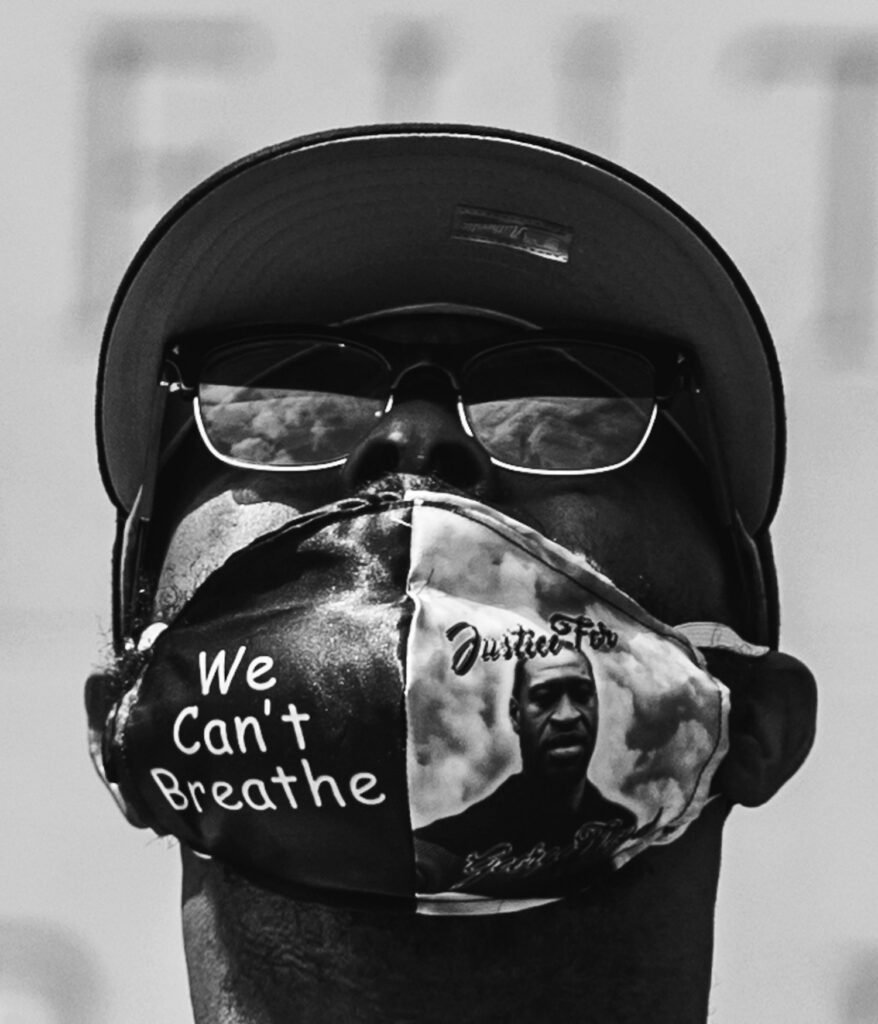
Terrence Floyd at his brother’s memorial in New York City this June.
Anthony Geathers for Rolling Stone
“That’s what you want; you want your radical demands to become popular,” says Cullors, now the chair of the advocacy group Reform L.A. Jails. “Then they become actionable, and then your elected officials won’t feel as scared to pass something like stopping a $3.5 billion jail because, hey, everybody else is saying the idea of caging thousands of human beings who have mental-health issues isn’t a good idea anymore.”
The Rev. Dr. Bernice King, CEO of the King Center in Atlanta and daughter of Dr. Martin Luther King Jr., speaks of her father’s own outspoken advocacy at the end of his life for divestment from the military-industrial complex and reinvestment in communities. “Because our police departments have become more militaristic, we have to redirect the funds and begin to put money into some of these more important social issues in our society like education and health and the environment,” King says. “So I would elevate it to say that we need to divest in militarism holistically, and reinvest in those issues that make us whole as a nation.”
Fifty years ago, the U.S. spent about as much on “law and order” — courts, law enforcement, and incarceration — as it did on items such as temporary financial assistance, food stamps, and Social Security. But as The Washington Post reported in June, the gap between the two has ballooned ever since. Today, “law and order” gets twice the spending as cash-welfare programs.
During that same stretch, the U.S. government has systematically defunded the black community. Tometi cited public-safety-net cuts under Republican presidents from Reagan through both Bushes, and now on to Trump, whose entire presidency has often demonstrated either an indifference or an open hostility to black survival. From lowering environmental standards to his willful mishandling of public-health crises, Trump has embraced the white-nationalism mandate his voters provided him after he ran arguably the most racially divisive campaign since George Wallace in 1972, even unleashing tear gas on peaceful protesters outside the White House during a respiratory pandemic.
As with any conversation about Trump’s racist policies or rhetoric, it cannot begin or end with him. The failures, on the federal and local levels, began long before his election, including the mediocre reforms that did nothing to contain the flow of money to law enforcement nor did much to curtail physical abuse. As a result, though overall rates of shootings of unarmed suspects have dropped since 2015, police are still four times more likely to kill unarmed black suspects than white ones.
This is why, as Harvard Kennedy School historian Khalil Gibran Muhammad says, Americans need to be aiming higher than short-term reforms. “We need to be talking about a massive reimagining of what a world with less policing actually looks like: [one] that is not an abstraction but is tethered to the Green New Deal, [one that] is tethered to the need to invest in public-health workers; they should also be the ones to help us do violence interruption, to be community-led initiatives for public safety, that don’t rely on the police. Period.”
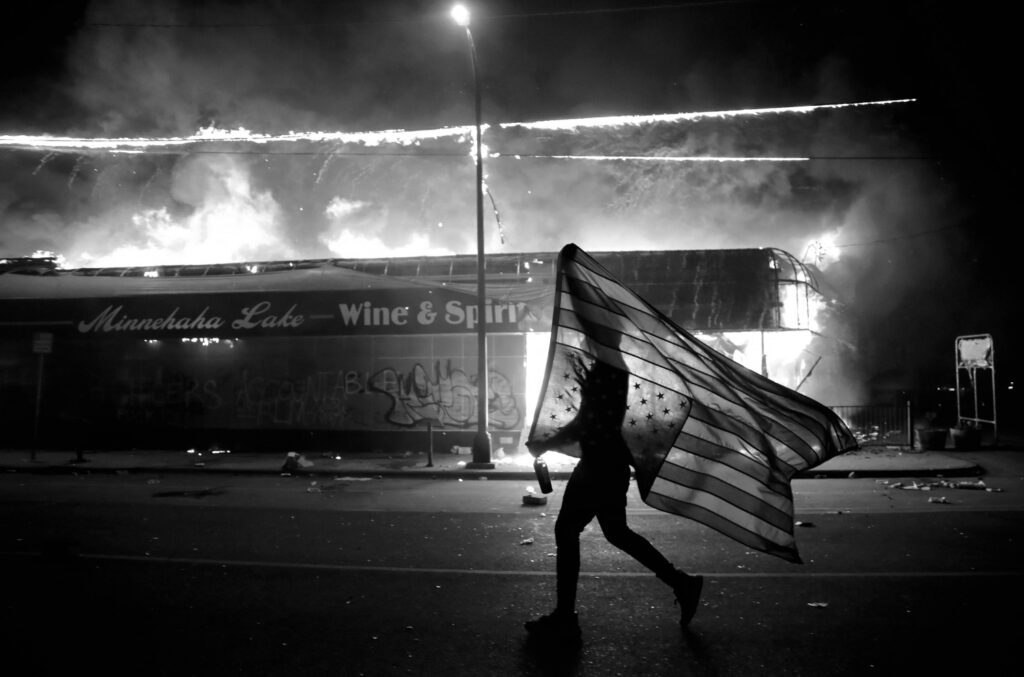
ALL AMERICAN BATTLEGROUND: The protests erupted in Minneapolis on May 26th, the day after Floyd’s death. Clashes with cops led to hundreds of arrests as the city mourned and raged.
Julio Cortez/AP/Shutterstock
And according to Muhammad, we can make these big asks now in large part not merely because of Garza, Cullors, and Tometi, but because of the framework they established. Black Lives Matter was born as an organization with a queer, feminist framework that grasped the importance of intersectionality. “Both Patrisse and I have this experience being queer black women in a movement for black freedom that really isn’t shaped in our image. One of the things that actually connected Patrisse and I very early on is what it meant to try to navigate that space,” Garza says.
That was especially important at a time when the media focused on black death centered on straight black men and boys. Since people are oppressed because of race, gender, and all of the various ways they are identified, if black lives are to truly matter, they all had to matter. It is to the movement’s credit that the deaths of trans people like Tony McDade and Nina Pop haven’t been lost in the shuffle of recent tragedies. But visibility hasn’t been the sole accomplishment.
“This moment crystallizes how important organizing is to movement work and movement building,” Muhammad says. “It’s clear that what they did helped to prepare, city by city, what is emerging as a national network of organizers who have been ready, willing, and able to step into a crisis. We have to see what’s happening here in terms of the nucleus of these massive protests being the outcome of all of that work.”
Organizer Brittany Packnett Cunningham, who emerged as a national leader during the Ferguson unrest in 2014, also wants to ensure that Americans give credit where it is due. “If I look at this moment through the lens of what has been built over the last six years, what I really think of is that everyone, from the people who are out on the streets right now to the people who are making phone calls and sending emails, everyone needs to thank a protester,” she says. “Because [of] those folks — from 2014, 2013, from the Nineties, the Eighties, the Seventies, the Sixties — it is the culmination of activity from thousands, if not millions, of people over generations that has finally brought America to a point of reckoning when it comes to the incredibly violent institution of policing.”
‘Yesterday was the first time I cried for joy,” Tometi tells me after the protests in early June. “Seeing the news clearly display our images and our slogans about defunding police, I was moved to see the people got the message. Because for far too long, we weren’t being heard. Part of why we even had to go to -Twitter and had to go to Facebook and had to use social media was because there was a silence around anti-black racism in our society. It was just a practical means of communicating.”
Change once painted as impossibly radical is becoming reality. After Minneapolis Mayor Jacob Frey refused to commit to defunding the police in early June, the City Council announced plans to disband the MPD entirely and invest in community-led public-safety efforts. Their move was certainly the most far-reaching early on, but the strong momentum for defunding police departments broke down even city leaders whose police forces had been notorious for their abuses.
After previously sticking to his plan to raise police funding by $19 million while making cuts to programs like youth-violence prevention, Philadelphia Mayor Jim Kenney announced in early June that he would eliminate that budget increase and review a proposed set of reforms. New York City Mayor Bill de Blasio, who had been trying to leave the NYPD’s nearly six percent chunk of the city’s $90 billion budget untouched, caved and pledged to cut police funding.
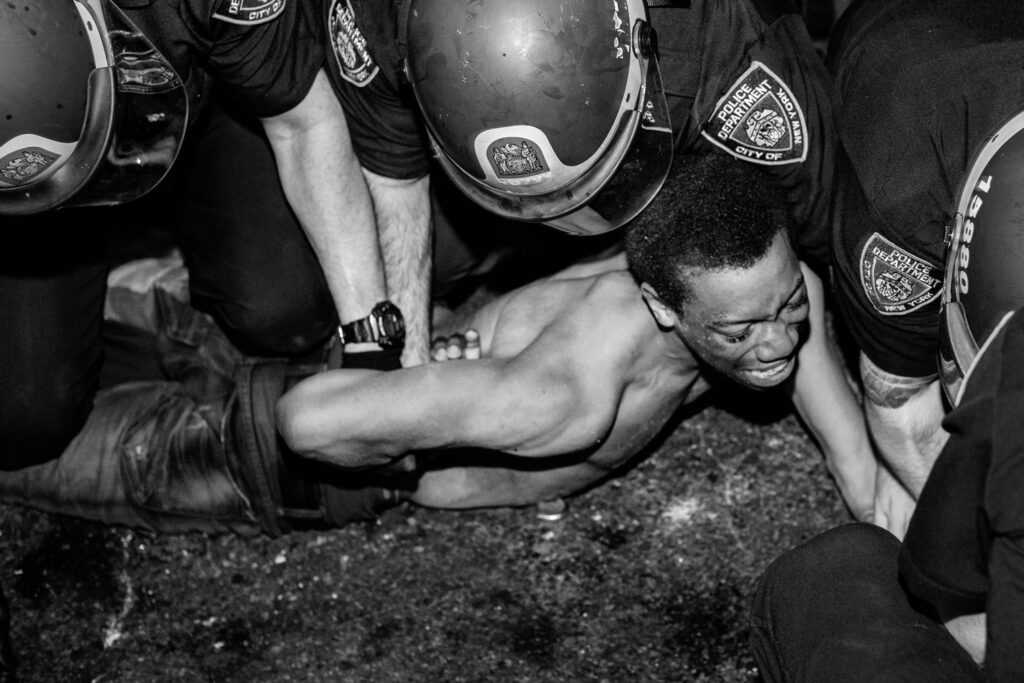
A VIOLENT SYSTEM: A Brooklyn protester being arrested in May. The police have responded with excessive force on many occasions during the protests
Amr Alfiky
It’s a handful of cities now, but it’s growing, and if adopted broadly, would interrupt the nation’s decades-long bipartisan binge on police spending and militarization. That alone seemed unthinkable even a month ago. Something is changing here.
I feel it, as well. Accountability after the fact used to be the most that I once hoped for, as a black man just living and trying to survive. Wishing for the cops not to target me indiscriminately felt almost like too much to ask. But I must be honest: If this era of Black Lives Matter activism has not resulted in the kinds of changes to America that would ensure my safety, then it has made me feel more secure in demanding those concessions from my country. And it seems, judging from the crowds in major cities and even in some of the whitest towns of Texas, Maine, and Montana, others agree with me. These peaceful marches look like flowing bloodstreams through cities that had been lifeless during the pandemic for the past several months, and that isn’t mere symbolism. They need to keep going, for there are still powerful people to be made uncomfortable.
For what it is worth, the three founders are pressing even harder as the battle rages. Cullors recently got “Measure R” passed in Los Angeles County, a measure that institutes civilian oversight of the sheriff’s department and focuses on improving psychiatric care, drug treatment, and other services for those incarcerated in county jails. “I’ve been in this movement now for 20 years,” she said, “and I’ve always been incredibly optimistic — almost to a fault. I think that so much of what I’ve seen over the last seven years is [that] the power of infrastructure and organizing cannot be undermined. When there’s a rebellion that happens, an uprising that happens, organizations play such a critical role. These are the opportunities where we get to make such big and bold changes.”
Tometi recognizes the urgency and unique nature of this moment. “Thinking about this moment, for me, leading up to this, it felt like we weren’t working fast enough,” she tells me, sounding exasperated. “Our work wasn’t as effective as it needed to be. We’ve received all of the awards. I’m like, ‘Dear God, I don’t want another award, I want this to end.’ I do not care for any more accolades! This to me is common sense. You don’t want to see people dying and being murdered like this.”
I took Tometi’s tone to heart when she said it. There was more exasperation than excitement in her voice. These have been a long seven years, and unimaginably so for activists immersed in this work. Black pain has always been conspicuous in America, physical or otherwise. Physical or emotional, it stands out like the keloids on the backs of our enslaved ancestors, seen in daguerreotypes with the raised welts they would wear forever as reminders of where the whip stung them. Just like the permanence of those scars, black people have always needed to put our own health at risk in order to reveal to America its own fatal comorbidities. There is likely no path to a Voting Rights Act in 1965 without the Bloody Sunday on Selma’s Edmund Pettus Bridge, without the murder of activist Jimmie Lee Jackson by an Alabama state trooper. It has always been crucial that white Americans first see violence visited upon the bodies of black people before a finger is lifted in the direction of equality, and 2020 is no different.

A NATION OF MILLIONS: The country saw the largest civil-rights protests in generations. On Burnside Bridge in Portland, Oregon, some 15,000 people laid down, hands behind their backs, for nine minutes to protest police brutality and the death of Floyd.
Andrew Wallner
Similarly, we need white people to be involved in the fight against these structures that serve them at our expense, but we shouldn’t need them to save us. I welcome those first steps so many of them took toward taking an active and conscious role, even if many were awkward or flat-flooted. People needed to learn what “anti-racism” meant. What books to read, where to send cash to help the struggle, and where to stop spending their money. And protests needed to manifest at this magnitude to force politicians to take meaningful action that wasn’t another session of sensitivity training. White people were marching en masse for the sanctity of black life. Now, all of a sudden, politicians were moving out of their seats to get things done.
When black folks begged for our survival in so many places before now, prayed over so many bodies, it was insufficient. When Eric Garner and Eric Harris and George Floyd and Javier Ambler begged for breath in police custody, they were ignored. Dr. King’s father, Martin, said in his final speech, “All we say to America is, ‘Be true to what you said on paper.’ The word of this nation has to mean something, eventually, to its black citizens. The words “black lives matter,” so courageously put forward by these three activists and carried forward now by legions, must be sustained by the actions and policies of those in powerful positions if they choose to utter them. That goes for NFL commissioners, studio executives, and politicians. The struggle continues to build an America where black people can breathe, one where we do not need white people to validate our demand to do so. Until we hold this nation accountable for failing to meet its own potential, our black lives won’t truly matter here.
